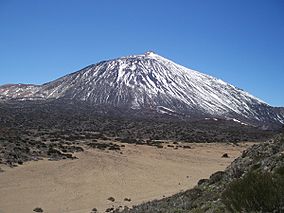Teide National Park facts for kids
Quick facts for kids Teide National Park |
|
|---|---|
|
IUCN Category II (National Park)
|
|

|
|
| Location | Tenerife, Spain |
| Area | 189.9 km² |
| Established | 1954 |
| Visitors | 3,5 million annual visits |
| Type: | Natural |
| Criteria: | vii, viii |
| Designated: | 2007 (31st session) |
| Reference #: | 1258 |
| State Party: | Spain |
| Region: | Europe and North America |
Teide National Park is a very popular place to visit in Spain. It is the most visited National Park in Spain. It is also one of the most visited national parks anywhere in the world!
This amazing park is found on Tenerife, one of the Canary Islands. At its heart is Mount Teide, which is 3,718 meters (12,198 feet) tall. This makes it the highest mountain in Spain. It is also the tallest peak on any island in the Atlantic Ocean. Mount Teide is actually a huge volcano. From its base, it is the third largest volcano on Earth!
Teide National Park was created on January 22, 1954. This makes it one of the oldest national parks in Spain. The park covers a large area of 18,990 hectares (about 73 square miles). Because it is so special, UNESCO named it a World Heritage Site on June 28, 2007. High up on the mountain, you can find the Observatorio del Teide. This is a place where scientists use telescopes to study space.
Contents
What Makes Teide National Park Special?
Teide National Park is famous for its amazing landscapes. It looks a lot like the surface of the Moon or even Mars! This is because of the volcanic rocks and different colors of the ground. The park has many unique rock formations. These were created by lava flows and erosion over millions of years.
The Mighty Mount Teide
Mount Teide is not just a mountain; it's a dormant volcano. This means it's not active right now, but it could erupt again in the future. The last eruption was in 1909. The volcano has a huge crater at its top. Around the main peak, there are smaller volcanic cones and craters. These show the long and fiery history of the area.
Unique Plants and Animals
Even though the park looks like another planet, many plants and animals live here! They have learned to survive in the tough conditions. The weather can be very cold in winter and hot in summer.
Plants of Teide
Many plants in Teide National Park are endemic. This means they are found only here and nowhere else in the world!
- Teide Broom: This plant has many small white or pink flowers. It grows in large patches across the park.
- Teide Violet: This tiny, beautiful flower is very special. It grows only at very high altitudes, close to the summit of Mount Teide. It is one of the highest-growing plants in Spain.
- Tajinaste: This plant is famous for its tall, red, cone-shaped flowers. It looks like a giant red spear! It blooms in spring and is a stunning sight.
Animals of Teide
You might not see many big animals, but the park is home to several interesting creatures.
- Canary Islands Lizard: These lizards are often seen sunbathing on rocks. They are very quick!
- Mouflon: These are wild sheep that were brought to the island a long time ago. They are good at climbing the rocky slopes.
- Birds: Many birds live in the park, including the Canary Islands Chiffchaff and the Blue Chaffinch. You might also see birds of prey flying overhead.
Exploring the Park
Millions of people visit Teide National Park every year. There are many ways to explore its wonders.
- Cable Car: You can take a cable car almost to the top of Mount Teide. This gives you amazing views without a long hike.
- Hiking Trails: There are many trails for walking and hiking. Some are easy, and some are very challenging. You can explore ancient lava flows and unique rock formations.
- Stargazing: Because the air is so clear and there's little light pollution, Teide is a fantastic place for stargazing. The observatory is a testament to how good the conditions are for looking at the night sky.
Remember to bring warm clothes, even in summer, as the weather can change quickly at high altitudes!
Images for kids
-
Echium wildpretii on Tenerife
See also
 In Spanish: Parque nacional del Teide para niños
In Spanish: Parque nacional del Teide para niños











